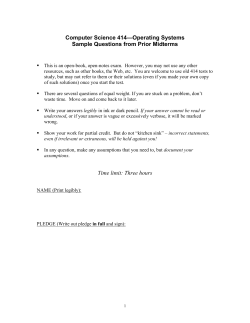
In Vitro Candice Hovell , Gilda Barabino , Lakeshia Taite
A Novel In Vitro Blood Brain Barrier Platform for Preliminary Drug Studies Candice Hovell1, Gilda Barabino1,4, Lakeshia Taite1,3 , and YongTae Kim1,2 1Coulter Department of Biomedical Engineering, Georgia Institute of Technology and Emory University, Atlanta, GA; 2Woodruff School of Mechanical Engineering, Georgia Institute of Technology; 3 Georgia Tech School of Chemical and Biomolecular Engineering 4Grove School of Engineering, City College of New York Cell Culture Validation Hydrogel Synthesis and Characterization A. B. C. D. Figure 1: Schematic of the BBB [1]. A. 25 20 15 10 5 0 5 10 15 Weight / Volume Percent… Existing in vitro models of the BBB are modified transwell designs that involve seeding the cells on either side of a semipermeable membrane. While these models do have the cellular geometry of mature in vivo BBB, the geometry is achieved through the incorporation of an additional, nonphysiological, component. This additional barrier limits the direct interaction of the cell types which in turn limits the degree to which the model will recapitulate in vivo BBB properties. Our objective is to develop a novel in vitro BBB model that incorporates both physiologically relevant flow and direct interaction of cell types for use in preliminary drug screening and toxicology studies. C. D. 5 4 Figure 8: 3D Static Culture. Confocal images of a mono culture of (A.) HBMEC, (B.) HBVP (C.) NHA cells and (D.) triculture of HBMEC (green), HBVP (red) and NHA (blue) in 250µm thick 5% modified gel hydrogels 4 days after encapsulation. Gels were submerged in culture media and incubated at 37°C and 5% CO2. 3 2 1 0 10% ModGel 5% ModGel Water Figure 5: Hydrogel Characterization. (A.) Mechanical stiffness as a function of weight by volume percent composition of modified gelatin hydrogels (B.) Fully swollen modified gelatin hydrogels pose negligible resistance to ion flow Device Fabrication Conclusions and Future Work Conclusions • A modified gelatin hydrogel has been synthesized and characterized that exhibits the relevant mechanical properties of brain tissue • Preliminary data indicates the modified gelatin provides a suitable substrate for the proliferation and migration of all cell types. • Prototype device fabrication shows promise for repeatable microchannel formation in modified gelatin hydrogels Future Work • Devices will be characterized via: • transendothelial electrical resistance (TEER) monitoring • visualization of tight junction proteins (ZO-1) • assessment of relevant cell surface receptor expression • permeability to key tracker molecules • Static tri-culture transwell models and pericyte free flow based models will serve as controls for comparison. Results will also be compared with published in vitro results from other devices and reported in vivo values [1-3]. Outlet Vessel geometry Inlet Figure 3: Comparison to existing devices. Schematic of existing µBBB device [2] containing transwell membrane between cells (left). Schematic of proposed barrier free BBB on a chip device (right). B. 6 Cell laden hydrogel TEER electrodes A. 7 0 Objective: Improved Microfluidic Platform Figure 7: 2D Static Culture. Tri-culture of HBMEC (green), HBVP (red) and NHA (blue). Seeding density of 2E5 cells/cm2 with a 2:1:1 ratio of HBMEC, NHA and HBVP cells respectively. Cells were incubated at 37°C and 5% CO2 and fluorescent images were taken after 18 hours of culture on (A.) no coating (B.) unmodified gelatin (C.) modified gelatin and (D.) Matrigel. B. Resistance Ωcm2 Figure 2: Available routes of molecular transport across the BBB. Non-polar or lipid soluble compounds can passively diffuse through endothelial cells into the cytoplasm (1). Carrier molecules chaperone necessary compounds (3) and remove unwanted compounds from the cytoplasm (2). Necessary, large, polar, molecules that cannot passively cross the lipid bilayer of the cell membrane are transported by either receptor mediated transcytosis (4) or adsorptive mediated transcytosis (5). Small polar molecules can passively diffuse through the tight junctions connecting neighboring endothelial cells (6) Figure 4: Schematic of Gelatin Acrylate-PEG-SVA Reaction. Gelatin macromolecules contain a number of free amines that are available for reaction. Modified gelatin is formed by covalently attaching photopolymerizable acrylate groups to the free amines on gelatin. The resulting copolymers can then crosslinked through exposure to UV light in the presence of a photo initiator (4-Dimethylaminopyridine). Young's Modulus (kPa) The blood brain barrier (BBB) poses a significant challenge to drug delivery. The BBB restricts the permeability of molecules from systemic circulation via a variety of specialized endothelial cell processes that result from exposure to the cell types of the neurovascular unit[1]. Preliminary Results Materials and Methods Introduction Figure 6: Schematic of device fabrication. (1.) Hydrogel constructs are made on glass slides by pipetting prepolymer solution into plasma cleaned PDMS molds and covering with acrylated glass slides before exposure to UV light (365 nm, 30 seconds). (2.) PDMS housings are cast on 3D printed master molds. Housings are cured at 85ºC overnight and plasma cleaned before use. (3.) Pseudo 3D constructs are made by placing a swollen hydrogel construct within a PDMS housing and bonding to a plasma cleaned glass slide. Fully 3D constructs are made by placing swollen hydrogel constructs within two separate plasma cleaned PDMS housings that are then bonded together. References and Acknowledgements [1] Abbott, N. J. (2013). Blood-brain barrier structure and function and the challenges for CNS drug delivery. J Inherit Metab Dis, 36(3), 437-449. doi: 10.1007/s10545-013-9608-0 [2] Booth, R., & Kim, H. (2012). Characterization of a microfluidic in vitro model of the blood-brain barrier (muBBB). Lab Chip, 12(10), 1784-1792. doi: 10.1039/c2lc40094d [3] Urich, E., Patsch, C., Aigner, S., Graf, M., Iacone, R., & Freskgard, P. O. (2013). Multicellular Self-Assembled Spheroidal Model of the Blood Brain Barrier. Scientific Reports, 3. doi: Artn 1500 Doi 10.1038/Srep01500
© Copyright 2025





















